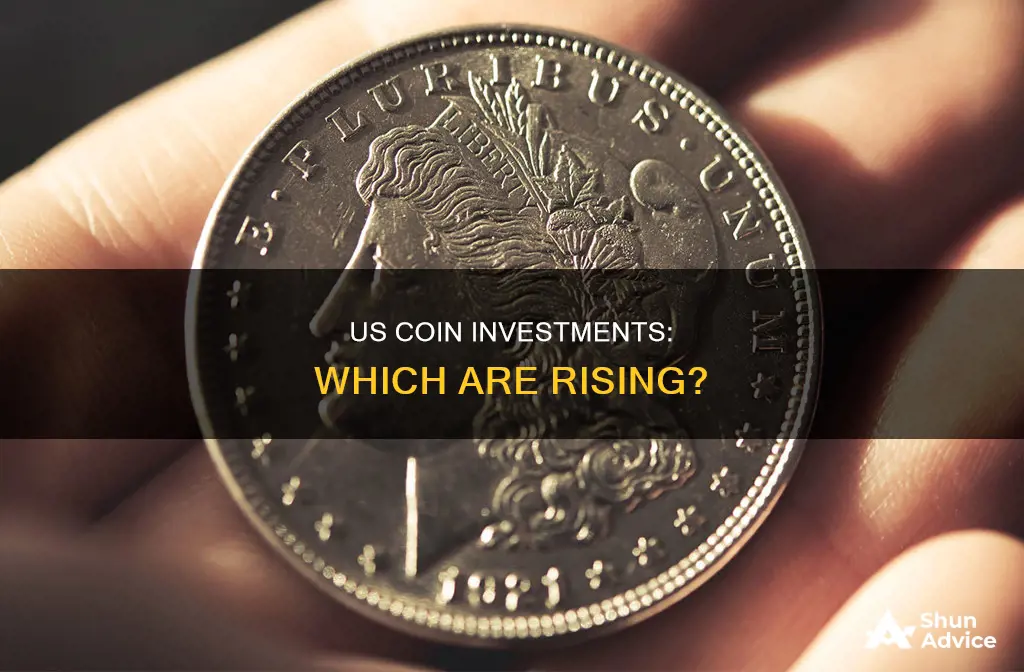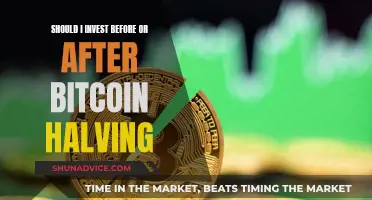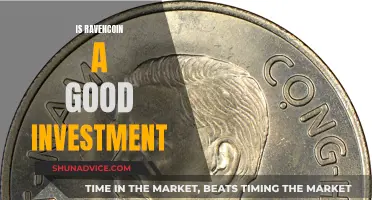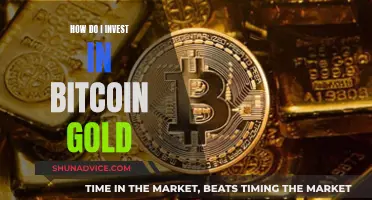
Rare coins can be a good investment, but it is a subjective area. The value of a coin is derived from its bullion value and its collector or numismatic value. The bullion value is calculated by multiplying the ounces of metal in a coin by the spot price per ounce of that metal. The collector value is harder to determine and is based on buyer sentiment. It is influenced by the number of examples of a coin that were minted, the condition of the coin, and its rarity.
Investing in rare coins can be profitable, but it is a long-term strategy. The market can be volatile, and there is a risk of counterfeit or doctored coins. However, rare coins can add diversity to a portfolio, and their value can increase over time.
When investing in rare coins, it is important to buy from reputable coin dealers and only purchase certified coins. It is also crucial to familiarize yourself with grading terms and buy the best-graded coins you can afford.
What You'll Learn

Rare coins as a commodity-like investment
Rare coins are considered a commodity-like investment, with the potential for attractive financial returns. They are a great way to diversify your portfolio and reduce risk, especially during times of economic uncertainty.
The value of a rare coin is determined by its bullion value and its collector or numismatic value. The bullion value is based on the physical metal content of the coin, usually gold or silver. The collector value, on the other hand, is influenced by factors such as rarity, condition, historical significance, and buyer sentiment.
When investing in rare coins, it is important to specialize your selection, scrutinize each addition, and study to grow your expertise. Grading is also crucial, as very fine distinctions between coins can significantly impact their worth.
While investing in rare coins can be lucrative, it is important to approach it as a long-term endeavour. The rare coin market can fluctuate, and it may take time to develop the knowledge and expertise needed to make wise choices. Additionally, it is essential to find reputable dealers and protect yourself against fraud.
One of the safest ways to invest in rare coins is through government-issued bullion coins, such as those from the US Mint. These coins have reliable purity levels and are widely recognized, making them a good option for investors seeking maximum profit.
In summary, rare coins can be a sound investment, offering both financial gains and the pleasure of owning a piece of history. However, it requires careful research, patience, and a trusted network of experts and dealers.
Best Bitcoins to Invest: Top Crypto Picks
You may want to see also

US Mint coins as bullion
When it comes to investing in coins, it's important to understand the difference between bullion and numismatic coins.
Bullion coins are valued by their weight and the fineness of the precious metal they contain. The US Mint produces bullion coins in gold, silver, platinum, and palladium. These coins are a convenient and cost-effective way for investors to add precious metals to their portfolios. The American Eagle Bullion Coin Program, launched in 1986, offers gold, silver, platinum, and palladium coins. The American Buffalo Bullion Coin Program, introduced in 2008, also offers gold bullion coins. These coins are sold through a network of authorized distributors and the price is based on the prevailing market price of the metal plus a small premium to cover minting and distribution costs.
On the other hand, numismatic coins are valued by limited mintage, rarity, condition, and age. They often contain various metals and components, giving them a lower melt value than bullion coins. While numismatic coins may not offer the same investment potential as bullion coins in terms of metal value, they can still be a fun and rewarding collection for those interested in the historical and cultural significance of coins.
When investing in US Mint coins as bullion, it's important to consider the current market price of the precious metal and the small premium added by the Mint. Additionally, it's worth noting that the US Mint does not sell bullion coins directly to the public, so investors will need to purchase through authorized distributors or dealers.
Overall, US Mint bullion coins can be a good investment option for those looking to add precious metals to their portfolios in a convenient and cost-effective manner. However, it's always important to do your own research and understand the risks and potential returns of any investment before making a decision.
Big Players Betting on Bitcoin: Who's Investing?
You may want to see also

US Mint coins as collectibles
Coin collecting is one of the world's oldest hobbies, historically practised by royalty and the very wealthy. Today, anyone can be a coin collector and investing in rare coins can be a great way to diversify your portfolio and reduce risk.
The US Mint offers a wide selection of numismatic items, including gold, silver, and platinum coins, as well as program coins, annual coin sets, proof sets, commemorative coins, and uncirculated coins.
Coin programs include limited-edition circulating coins, uncirculated coins, proof sets, gold bullion, silver bullion, and platinum items. Sets are produced annually and are available in special finishes and collections to mark special occasions. Commemorative coins, authorised by Congress, use rich symbolism and artistry to commemorate important aspects of American History, such as the Negro Leagues Baseball 2022 Proof Silver Dollar.
The US Mint's numismatic programs are self-sustaining and operate at no cost to the taxpayer. The Mint is the Nation's sole manufacturer of legal tender coinage and is responsible for producing circulating coinage.
When investing in rare coins, it is important to specialise your selection, scrutinise each addition, and study to grow your expertise. It is also important to be aware of fraud in the coin collecting world. The Federal Trade Commission and the Commodity Futures Trading Commission regularly issue warnings to help protect consumers from fraud.
Gold Coin Investment: Where to Buy?
You may want to see also

Grading rare coins
The two most trusted and renowned coin grading companies are the Professional Coin Grading Service (PCGS) and the Numismatic Guaranty Company (NGC), both located in California. These companies provide unbiased opinions on the condition of coins and have graded almost 70 million coins since their inception about 30 years ago. They use the industry-standard Sheldon grading scale, which was invented by William Herbert Sheldon. This scale uses the first 59 numbers to deal with circulated coins and the last 11 numbers for uncirculated coins.
The grading process involves several stages:
- Initial evaluation: Expert graders examine the coin under magnification to assess its condition.
- Cross-examination: Multiple graders cross-examine the coin to ensure a consensus is reached.
- Encapsulation: The coin is then encapsulated in a protective holder, which includes a label detailing its grade. This provides a reliable and tamper-proof certification of its condition.
It is important to note that grading a coin does not always increase its value. In some cases, the cost of grading may outweigh the added value to the coin. Therefore, it is recommended to only grade coins if the cost of grading is less than the extra value that grading will add. Additionally, the time required for grading, including shipping and insurance, should also be considered.
Libra Coin: A Guide to Investing
You may want to see also

Numismatics
Understanding Numismatics
Factors Affecting Coin Value in Numismatics
The value of a coin in numismatics is influenced by several factors:
- Rarity: The rarer a coin is, the higher its value tends to be. Coins with low minting numbers or those that are harder to find can command higher prices among collectors.
- Condition: The condition of a coin is crucial. Coins that are in uncirculated or near-perfect condition tend to be more valuable than those that show signs of wear and tear from circulation.
- Historical Significance: Coins with historical significance, such as those minted during specific historical events or from ancient civilizations, often carry a higher value.
- Metal Content: Many collectible coins contain precious metals like gold or silver. The bullion value, or the weight of the metal in the coin, contributes to its overall worth.
- Minting Errors: Rare minting errors, such as misprints or unique variations, can increase a coin's value in the eyes of collectors.
- Grading: Professional grading of a coin's condition and rarity is essential. Coins with higher grades, indicating superior condition and rarity, will generally be more valuable.
Tips for Investing in Numismatics
If you're considering investing in numismatics, here are some tips to keep in mind:
- Specialize Your Collection: Focus on a specific area of interest, such as a particular time period, region, or type of coin. This helps create a more valuable and focused collection.
- Research and Study: Educate yourself about the coins you're interested in. Learn about their history, rarity, and market values. "Buy the book before the coin" is a common saying in numismatics, emphasizing the importance of knowledge.
- Deal with Reputable Sources: Only purchase coins from reputable dealers, auction houses, or fellow collectors. Ensure you're familiar with grading standards and always get a second opinion before making a significant purchase.
- Start with a Small Investment: Begin with a modest investment and gradually build your collection. Focus on rare coins with historical importance, but exercise caution and seek expert advice when dealing with high-value coins.
- Consider Bullion Value: While numismatics focuses on the collector's value of coins, don't neglect the bullion value, especially for antique coins containing precious metals.
- Look for Bargains: Keep an eye out for undervalued coins at estate sales, antique stores, or coin shows. Learning to recognize bargains is a valuable skill in numismatics.
- Enjoy the Hobby: Remember to enjoy the hobby! Numismatics should be a blend of passion and investment. Collect coins that interest you, even if they may not be the most profitable.
Risks and Considerations
As with any investment, there are risks and considerations to keep in mind:
- Subjectivity and Volatility: The value of a coin can be highly subjective, and the rare coin market can fluctuate. Grading standards may vary, and small distinctions between coins can significantly impact their worth.
- Fraud and Misrepresentation: Numismatic investing carries the risk of fraud, false claims about grading, or misrepresented coins. Always research dealers and get second opinions to protect yourself.
- Long-Term Investment: Numismatic investing typically requires a long-term horizon. Rare coins may take time to appreciate in value, and quick profits are less common.
- Storage and Maintenance: Properly storing and maintaining your coin collection is essential. Consider the costs and logistics of safely storing your investment over the long term.
In conclusion, numismatics offers a unique opportunity to blend historical interest, aesthetic appreciation, and financial investment. By understanding the factors that drive coin values, conducting diligent research, and approaching numismatics with a collector's spirit, investors can explore the potential financial gains in this fascinating area of coin collecting.
Commemorative Coins: Worthy Investment or Costly Collectible?
You may want to see also
Frequently asked questions
Any investment has inherent risks, and coin collecting is no different. The rare coin market can fluctuate, along with precious metal pricing, which will affect the value of your investment. If you want short-term profits, coins may not be the best investment vehicle.
Rarer, key-date coins issued by the United States in the best grade you can afford are the best types of investment coins. If you can't afford a key date in a high grade, then purchase common coins in the finest grades available.
The most profitable way to make profits from US Mint coins is to capitalise on the rarity aspect. Rare coins are most likely to fetch more money among collectors and investors. You can buy these from the US Mint website (usmint.gov).
One of the best ways to invest in precious metals is to purchase physical metals like bullion coins and bars. You can make these purchases through gold exchange-traded funds. The gold exchange system helps collectors and investors create a portfolio that allows them to know the best prices and market conditions to purchase the metals.
Bullion has a higher "melt value" (the value the metal would be worth if melted down). Numismatic coins, because they are often much older and made of various metals and components, have a lower melt value. They're worth less when melted than they are in coin form.







